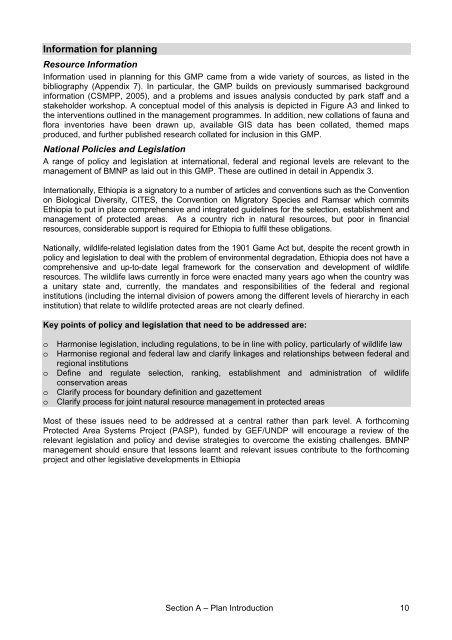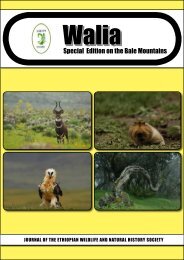Bale Mountains National Park - Zoologische Gesellschaft Frankfurt
Bale Mountains National Park - Zoologische Gesellschaft Frankfurt
Bale Mountains National Park - Zoologische Gesellschaft Frankfurt
You also want an ePaper? Increase the reach of your titles
YUMPU automatically turns print PDFs into web optimized ePapers that Google loves.
Information for planning<br />
Resource Information<br />
Information used in planning for this GMP came from a wide variety of sources, as listed in the<br />
bibliography (Appendix 7). In particular, the GMP builds on previously summarised background<br />
information (CSMPP, 2005), and a problems and issues analysis conducted by park staff and a<br />
stakeholder workshop. A conceptual model of this analysis is depicted in Figure A3 and linked to<br />
the interventions outlined in the management programmes. In addition, new collations of fauna and<br />
flora inventories have been drawn up, available GIS data has been collated, themed maps<br />
produced, and further published research collated for inclusion in this GMP.<br />
<strong>National</strong> Policies and Legislation<br />
A range of policy and legislation at international, federal and regional levels are relevant to the<br />
management of BMNP as laid out in this GMP. These are outlined in detail in Appendix 3.<br />
Internationally, Ethiopia is a signatory to a number of articles and conventions such as the Convention<br />
on Biological Diversity, CITES, the Convention on Migratory Species and Ramsar which commits<br />
Ethiopia to put in place comprehensive and integrated guidelines for the selection, establishment and<br />
management of protected areas. As a country rich in natural resources, but poor in financial<br />
resources, considerable support is required for Ethiopia to fulfil these obligations.<br />
<strong>National</strong>ly, wildlife-related legislation dates from the 1901 Game Act but, despite the recent growth in<br />
policy and legislation to deal with the problem of environmental degradation, Ethiopia does not have a<br />
comprehensive and up-to-date legal framework for the conservation and development of wildlife<br />
resources. The wildlife laws currently in force were enacted many years ago when the country was<br />
a unitary state and, currently, the mandates and responsibilities of the federal and regional<br />
institutions (including the internal division of powers among the different levels of hierarchy in each<br />
institution) that relate to wildlife protected areas are not clearly defined.<br />
Key points of policy and legislation that need to be addressed are:<br />
o Harmonise legislation, including regulations, to be in line with policy, particularly of wildlife law<br />
o Harmonise regional and federal law and clarify linkages and relationships between federal and<br />
regional institutions<br />
o Define and regulate selection, ranking, establishment and administration of wildlife<br />
conservation areas<br />
o Clarify process for boundary definition and gazettement<br />
o Clarify process for joint natural resource management in protected areas<br />
Most of these issues need to be addressed at a central rather than park level. A forthcoming<br />
Protected Area Systems Project (PASP), funded by GEF/UNDP will encourage a review of the<br />
relevant legislation and policy and devise strategies to overcome the existing challenges. BMNP<br />
management should ensure that lessons learnt and relevant issues contribute to the forthcoming<br />
project and other legislative developments in Ethiopia<br />
Section A – Plan Introduction 10
















